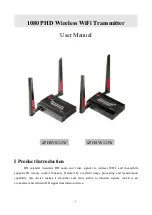
circuits have been energized to prevent battery drain by the 1
Farad capacitor. The batteries can be installed while the transmit-
ter is ON. (Do NOT use rechargeable batteries, such as NiCad
cells. The cell voltage is not high enough for reliable operation).
2.15.13
Recording Normal Meter Readings
We strongly recommend that a permanent record of ALL meter
readings be made, with carrier only (no modulation) and with
modulation at one or more levels (-95% should be one level). The
form at the end of this section provides an outline. Data should
be taken using the primary or main antenna system and a dummy
antenna (dummy load) if one is available, because a dummy load
will provide the most repeatable set of conditions.
2.16
AM Stereo Installation and Tuning
Hints
The transmitter is stereo ready in terms of interfacing with the
stereo exciter. The most difficult part of making a transmitter
stereo ready is minimizing the IQM, increasing RF bandwidth,
and reducing L-R noise. All these were taken into consideration
in the design of the transmitter. This results in a transmitter which
essentially requires NO compromise of efficiency, tuning, or
mono performance to obtain the best stereo performance. When
most controls are set for best stereo performance, the other
performance areas are also optimized.
2.16.1
Interfacing For Stereo
Connect the RF output of the stereo exciter through a BNC cable
to J2 on the Oscillator. Move Jumper P3 to position 1-2. This
enables the external drive input. Move P5 to position 1-2 for most
TTL exciter RF outputs. This is a 20k Ohm termination. Move
P5 to 1-3 for a 50 Ohm termination needed for higher level exciter
RF outputs.
2.16.2
Bandpass Tuning 2C1
The Bandpass tuning is the only control that will affect the
Incidental Phase Modulation (IPM) of the transmitter. Normally,
the Bandpass tuning is adjusted for peak power output on the
power meter, and then turned approximately one turn counter-
clockwise off the peak on the inductive side of resonance. This
typically optimizes efficiency, IPM and mono THD and IMD.
The bandpass tuning can be adjusted while the transmitter is ON
and modulating.
NOTE
THE TUNING CONTROL SHOULD NOT BE ADJUSTED
MORE THAN 2000W OFF OF THE POWER PEAK. MOST EF-
FICIENT OPERATION OCCURS AT OR NEAR THE POWER
PEAK. TUNING OFF THE PEAK IN THE CAPACITIVE
(CLOCKWISE) DIRECTION CAN REDUCE EFFICIENCY AND
CAUSE EXCESSIVE HEATING OF THE RF AMPLIFIER MOD-
ULES.
2.17
Remote Control Connections
The following paragraphs include basic information on remote
control interfacing. Remote Control connections (including con-
nection to extended control panels, if used) can be different for
each installation.
The Customer Interface for remote control, metering, and status
monitoring is compatible with nearly all remote control systems.
If the remote control system does not have enough channels
available for all control and status functions, Table 2-4 lists the
minimum recommended control and monitor functions.
All connections are made on TB1 and TB2 in the Center Control
Compartment. Sheet 3 of the External Interface schematic, 839-
7855-090, in the Drawing Package shows the list of remote
control functions with a letter (A through E) placed next to each
terminal number. This letter refers to the Characteristic Key on
the diagram. Each Characteristic Key provides schematics and
information which will be useful when planning interfaces to a
remote control unit or to an extended control panel. For detailed
information, including typical interfaces, refer to SECTION N,
External Interface.
2.17.1
Control Inputs
Control Inputs are isolated by optoisolators on the External
Interface. This permits maximum flexibility, allowing use of
voltage sources provided on the External Interface or external
voltage sources. Control inputs can be a relay contact closure,
switch closure, or transistor switch. Control inputs may be iso-
lated from ground, or can be switched to ground by a positive or
negative voltage. Each remote control input uses a “+” and “-”
terminal on TB1 or TB2. Applying a voltage between the termi-
nals is the same as depressing the corresponding button or
operating the corresponding switch on the transmitter. Voltage
applied to these terminals should be between 15 and 29 Volts;
corresponding currents are 40 to 70 milliamperes. For conven-
ience, +15 VDC and -15 VDC sources (at 175 mA maximum
current) are provided at TB1-11 and TB1-12, respectively.
2.17.2
Analog Monitoring Outputs
These remote meter readings monitor voltages, currents, power
levels, and other analog parameters. When a high impedance
remote control system input is connected to a Monitor Output
terminal, the nominal output will be +3.4 Volts (or -3.4 Volts to
monitor -22 V and -8 V supplies) when the transmitter is operat-
ing at 25 kW. This allows for some increase in readings while
still remaining within the 4 Volt input limit of remote control
systems such as the Harris Sentinel. If the remote control system
input is not high impedance, the loading on the monitor output
will reduce the output voltage.
2.17.3
Status Monitoring Outputs
These are open-collector outputs to ground. When the corre-
sponding status indicator is illuminated at the transmitter (or
when a ColorStat™ panel LED is RED), the transistor turns ON
and provides a current sink from the status output to ground.
These status outputs can switch a 6 or 12 VDC low-current relay,
Section II - Installation
Rev. AA: 8/9/2000
888-2297-002
2-13
WARNING: Disconnect primary power prior to servicing.
Содержание DX 25U
Страница 2: ......
Страница 10: ......
Страница 28: ......
Страница 32: ......
Страница 46: ......
Страница 58: ......
Страница 82: ......
Страница 150: ......
Страница 158: ......
Страница 166: ......
Страница 174: ......
Страница 176: ......
Страница 196: ......
Страница 206: ......
Страница 212: ......
Страница 218: ......
Страница 270: ......















































